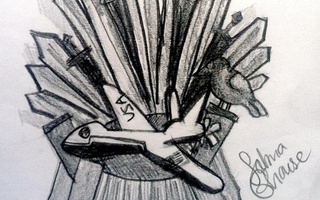Drone strikes have received attention from nearly every academic association and think tank, including the American Society of International Law, the Council on Foreign Relations, and the Naval War College. And, for better or worse, they have become a permanent feature of American foreign policy debates, from journalists and policymakers to human rights groups and non-governmental organizations.
Of course, these discussions are vital and necessary. The ideals of American democracy and the unprecedented questions of their use require extensive discussions on drone strikes. Yet, no one has discussed drone strikes in relation to another critical development of U.S. national security policy, the eroding distinction between war and peace, a topic recently highlighted in the Washington Post’s series on the Permanent War.
Recent discussions have connected the topics only in terms of current changes in national security policy. An article on the forever war may use a picture of a drone strike or it may use the expansion of drone bases as an example of the ways in which counterterrorism operations have expanded.
Yet, the relationship between drone strikes and temporal distinctions of war and peace is much more complex. Recent developments in national security policy show much more than an incidental connection between the two.
We may soon enter a point in which autonomous weapon systems actually define the distinction between war and peace.
In the past few years, the United States has pursued counterterrorism operations throughout the world while minimizing the commitment of American troops throughout the world. As a result, U.S. national security policy has become increasingly dependent on weapons technologies to replace conventional forces.
Granted, this is not a new phenomenon. In fact, it significantly echoes Eisenhower’s policy of massive retaliation. However, nuclear weapons did not influence the distinction between war and peace since they represented the culmination of total war. Drone strikes may influence the nature of modern warfare in much more profound ways.
West Africa may have already set the precedent for these changes. In October, France announced that it would send drones to Mali as an effort to combat Islamic insurgents. A couple of weeks ago, France made the decision to send actual combat forces to the region. In response to this announcement, the United Kingdom provided combat support units, which is a fairly typical response in these situations. At the same time, the United States has announced that it will build a drone base in Niger to support counterterrorism operations in West Africa.
France’s decision to use drones acted as only one stage of escalation towards war in a manner similar to the deployment of support units. Similarly, the decision of the United States to establish a drone base operates in a manner similar to the traditional practice of support troops in post-conflict settings.
These developments, along with the proliferation of drone bases throughout the world, point to a world in which the distinction between peace and war defines itself in terms of the decision to deploy people as opposed to technology. Since drones represent an escalation towards combat or a withdrawal from combat, times of war may only occur in relation to the use of actual combat forces rather than the use of technologies like drones.
However, this distinction is troubling on several levels. To start, drones have combat abilities in themselves. If these definitions of war and peace took effect, a tool of war may be used in a time of peace, particularly as a final step before the decision to deploy combat forces. At best, the new definition of war and peace remains nebulous. At worst, all drone strikes may violate the laws of war, a concept with particularly daunting consequences for the strategic doctrine of the Obama administration.
To get around this difficulty, then, the laws of war would require the use of armed drones only in accompaniment with the use of combat forces, in a manner similar to the current use of American combat drones in Afghanistan.
Although this requirement may negate the strategic advantage of a drone strike, namely the ability to target enemy combatants without risking the lives of your own soldiers, it also provides several advantages. It ensures the presence of human intelligence on the ground, which is necessary to minimize collateral damage, and it negates the biggest risk of armed combat drones, by reducing the cost of military engagement to the point that force no longer becomes a necessary option of last resort.
By connecting the use of armed drone strikes to a time of war necessitating the use of combat forces, policymakers could reduce the current ambiguities of national security policy, a field defined partly by our attempts to provide order in a fundamentally anarchic world.
Raul Quintana ’14, a Crimson editorial writer, is a social studies concentrator in Leverett House. His column appears on alternate Fridays.
Read more in Opinion
Letters to the Editor: Teach For AmericaRecommended Articles
-
God Bless DronesThese strikes are not only wiping out threats, but they are also preventing present insurgent forces from organizing themselves effectively.
-
Our Very Own Campaign of TerrorThe US needs to significantly reform its use of drones in the region, if not completely abolish it.
-
 Should The United States Use Drones for Military Operations?
Should The United States Use Drones for Military Operations? -
Don’t Drone Me, BroThe United States has been carrying out a program that devastates innocent lives and harms American interests without admitting to it, choosing instead to actively lie about it for some time.
-
Undoing Due ProcessThis newly claimed assassination power is only the most recent (and most egregious) in a series of executive overreaches committed in the name of fighting terror.
-
 Game of Drones
Game of Drones













